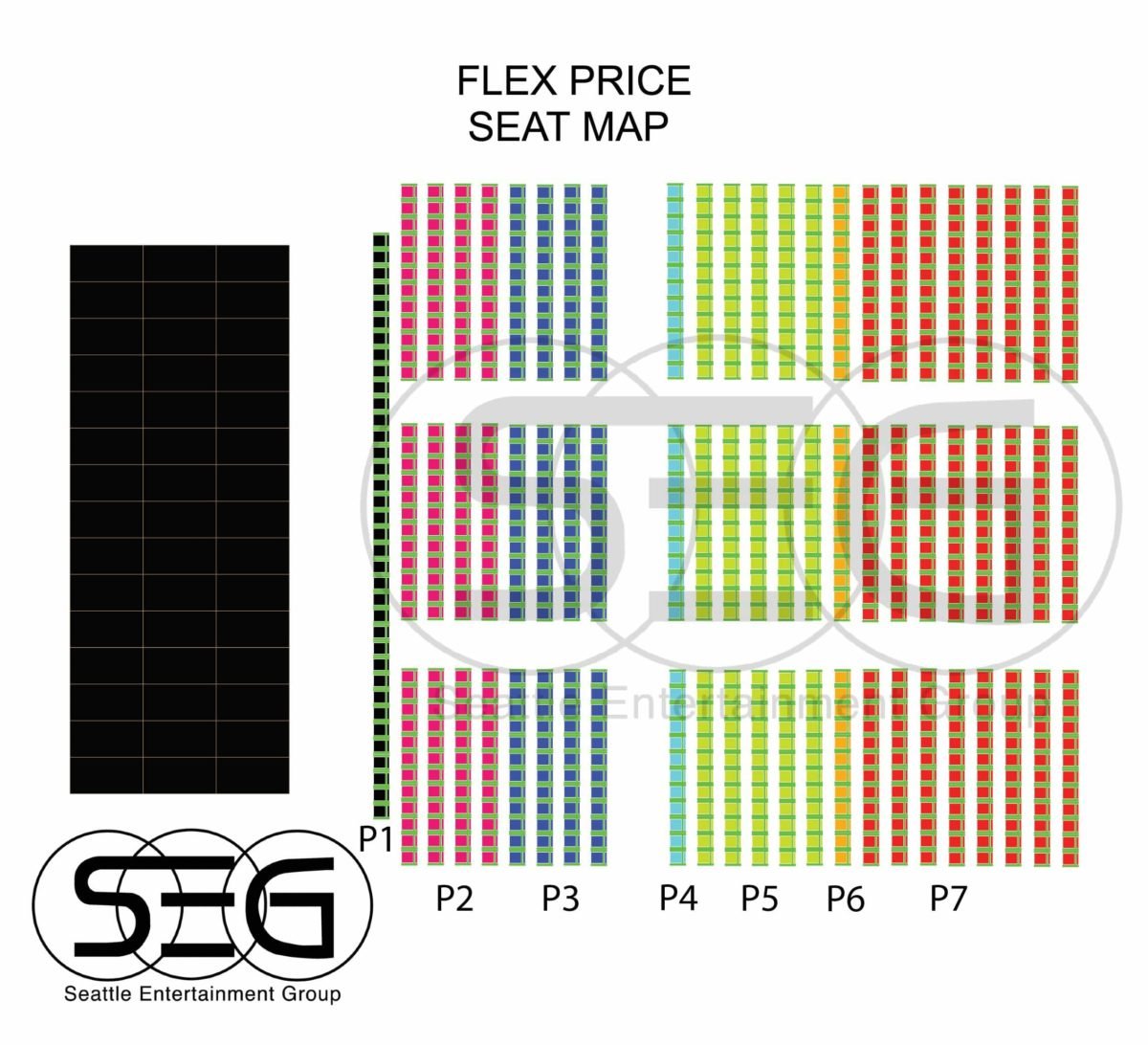Flex Scaling & Price Level Strategy For Casino Concerts
Home »
It takes time and skill to properly create a seating manifest, assign price levels, create ticket scaling, and design seat maps for any casino or concert venue. Simultaneously, it is important to remember that managing your online ticketing platform and the onsite box office is the most important function of your casino’s entire entertainment program. Unfortunately, the average casino talent buyer isn’t going to help you place VIP holds, create your seating manifest or design the layout for your event (and that is okay). But at SEG we pride ourselves in being multifaceted casino talent buyers with a bias for ticketing, speed, and efficiency.
After researching and experimenting with hundreds of different strategies, we have discovered one of the most successful approaches to scaling and applying price levels in any venue or ticketed event. Before you put a show on sale, take a look at our general 5 step ticketing guide and the Flex price level strategy we have outlined below.
Step 1 Seating Manifest
Step one is the most important step for a reason. You have no chance of programming a show in your ticketing platform without a defined seating manifest. This step is the most important because you need to know how many seats you want to present in any given space before you can comfortably scale, place holds or start selling tickets to a show or event. It seems simple, but venue operators will go to great extents to avoid the extra work of laying this foundation for their venue. A seating manifest is not the same as a seating chart or seat map. A seating manifest shows the layout in an alphabetical and numerical format (usually in a spreadsheet). And a seating chart typically shows the venue’s seating arrangement from a more artistic perspective in an aerial point of view. The seating chart uses symbols for the seats and shows their placement, isle space, and in most cases the price levels.
Step 2 Assigning Price Levels
There is no wrong way to set price levels when designing your venue’s seating arrangement. We believe that the number of price levels should reflect the number of sets in your venue. For example; if you have less than 1,000 seats, we recommend creating between 6 and 8 price levels. If you have 2,000 seats or less, consider 9 to 14 price levels. If you are a football stadium or have several thousand seats, we recommend anywhere from 15 to 25 or 30 or more price levels. Of course, the actual amount is subjective. This is where you must decide your venue’s strategy. For a smaller comedy club with 500 seats, you may only want 2 or 3 price levels. In general, the more price levels you have, the more profitable you will be.
Pro Tip:
One of your price levels should always be considered as the lead-in price. That way you can message “tickets as low as $19.99”(or whatever is appropriate for that shows lead-in price). Also, always limit the volume of seats in the lead in the price level. Most concert-goers will not know how many cheap seats are available. The purpose of this price level is to show approachability and to help your marketing efforts.
Step 3 Ticketing Scaling Tool
Your venue operators and casino talent buyer should know the exact amount of revenue you stand to make in the event a concert or show sells out. Of course, there may be a slight variation in the actual gross due to additional last-minute COMPS, trouble seats or other added holds, but in general, the profit should be apparent before you put your offer in for an artist or band. Simply put, having something similar to our scaling tool is essential to your venue’s financial success. At SEG we can help create or consult during the creation of your concert ticket scaling tool.
In some cases, you may need multiple scaling tools since not all concerts have the same manifest, or, layouts. The pricing tool is a simple but crucial tool that should help define your venue’s ticketing strategy. The standard scaling tool shows how many seats in each price level (minus holds, COMPS, and kills), the gross revenue for each price level, and the color of each price level in your seat map. Plus, if you are using any other ticketing platform other than Ticketmaster, you should also include the revenue from ticket fees and service fees (since most cloud-based ticketing platforms allow the venue to set and retain the ticket fees).
Step 4 Final Ticket Scaling
To create your ticket scaling, you and your casino talent buyer will need to determine what artist you want to hire first. After you decide what artist you want to hire, the offer you send into their booking agent will need to include your ticket scaling. Before you can send accurate scaling to the agent, you will need to reference similarly sized venues in a similarly positioned market to determine the high and low price points of the artist’s ticket value. This is important because ticket holders will do the same thing. If concertgoers see your venue selling top tier tickets for $85 to a Chubby Checker concert at your casino, and the theatre 75 miles away is selling them for $45, your sales will suffer because of the inconsistency. If your booking shows in a concert venue that is inside a tribal casino, you probably do not want to reference the same artist’s ticket prices in a stadium setting. It may also be a good idea to visit Pollstar to see the average gross sales for your artists of choice. That will give you a sense of the artist’s inflated gross potential.
For theatres and larger venues outside of Indian country, the artist’s agent generally wants to see your ticket scaling. The booking agency asks to see the scaling for a few different reasons. The main reason these agents want to know your scaling is so they know how much money you are making off the show. The second reason is more speculative, but many believe certain agents are scalping tickets on the 3rd party market (which is considered embezzling). Lastly, agents want to see scaling so they know that an artist’s fans are not being gouged.
When deciding what band to hire, ticket scaling is of the utmost importance. For tribal casinos, it can be more complex because there are comps, kills and other seat holds to consider. Since all native casinos are typically overcharged for talent, it can be challenging to create profitable scaling for your concert. There is more than one way to overcome this unethical price hike though, and the best method will ultimately be a combination of what SEG recommends and your venue manager’s entertainment strategy.
Pro Tip:
Your casino talent buyer does need to convey scaling in most cases. That does not mean they need to disclose ticket fees and service fee profitability. Some venues make $15,000 + in fees on a single show and if you are using the right ticketing platform, you will keep 95% (or more) of that revenue.
Step 5 Design Seat Map
This step is probably the most enjoyable because you get to see the fruits of your labor represented artistically. Designing the seat map is also going to help your box office tremendously. Front line employees like the ones in your ticketing box office will always be more efficient and provide better customer service if they have the tools and resources they need to find holds, price levels, and pertinent ticket info all in one place. Additionally, some ticket holders want to handpick their seats and this resource allows them to do just that while onsite at your box office. Obviously the cloud-based ticket platform you use will also have a seat map, but those maps generally show the arrangement on a per section basis. Meaning, if you have 3 sections (A, B & C), you can only zoom into one section at a time. And, I promise you handing over a laminated seat map so your guests can see the map from a holistic perspective will have them grinning with excitement.
Most box office seat maps should include the following:
- Row numbers
- Seat numbers
- Holds/Unavailable VIP seats
- Price Levels
- Stage location
- Entry and Exit locations
- A map key
- Aisle Location
- Venue Name
Scaling Flex Price Level Strategy
If your venue wants to be profitable, consistent, and organized, then you will need to create a pricing and overall venue strategy. The strategy should be decided before you build your manifests, scaling tools, or seat maps. Some venues adopt a premium pricing strategy while others prefer more approachable or affordable pricing. Depending on the venue size, you and your casino talent buyer might want to evaluate volume versus value. Unfortunately in entertainment venues, size matters, and the fewer seats you have the less flexibility you have in regards to profitability and strategy.
The Flex strategy is a good strategy for most venues because of its versatility. If you have 500 – 1000 seats, then you could easily implement this strategy. There are only a few steps to follow in order to successfully implement the Flex Ticketing strategy. First you will need to know on average how full your shows get. After you have determined your average volume, you can then use that as your baseline to determine where to place your lead-in price level. If your venue has 23 rows, and on average your venue is 70% full, then your lead-in price should be somewhere near row 16 or 17. Additionally, anywhere you have a break in the rows (including the front row) should be marked as its own price level. Remember people are always willing to pay more for easy access and legroom.
To put this in perspective, take a look at the hypothetical price levels below:
- Row 1 P level #1
- Row 2 through 5 P level #2
- Row 6 through 9 P level # 3
- Row 10 (isles) P level # 4
- Row 11 through 15 P level #5
- Row 16 (lead-in price) P level #6
- Row 17 through 24 (blocked until you see demand increasing) P level #7
With these price levels in the right places, you can then effectively manipulate pricing (up or down), and seating availability. If you block off the furthest rows in P7, it gives you the ability to do three things. First, when the show starts filling up, you can then release seats, and even raise prices before you do. Additionally, you can leave the seats closed if it underperforms, and spread the rows of your seats out so the room looks more full. The extra width in the isles will also allow cocktail service if the entertainer and event space allow beverage service during the show. Lastly, you will avoid huge gaps in the venue where a ticket purchaser decided to buy a seat in the last row since it was cheaper.
Call us, or consult with your casino talent buyer before making any changes to your pricing, price levels, or layout. Any alterations after the shows are on sale or after the offer has been submitted could have serious repercussions.

